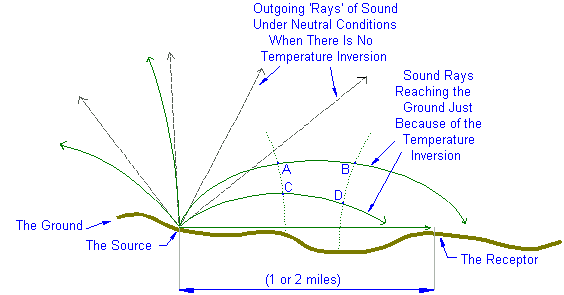
Temperature Inversions & Sound Propagation

by Mike O'Connor (a legacy web page, circa 1997)

This conceptual diagram shows how the influence of a temperature inversion can sometimes cause distant sources of noise to sound much closer than they really are. All of the curved lines on the diagram, those drawn in green, pertain to atmospheric conditions when an inversion is present; the straight, gray dotted lines depict sound propagation during 'neutral' atmospheric conditions when there is no inversion. The diagram does not pertain to windy conditions, as wind has other effects on sound and inversions don't exist near the ground when wind speeds are high.
For most of the lowest 10 miles or so of the atmosphere the primary tendency of the temperature of the air is as follows: the higher the elevation above the surface of the earth, the lower the temperature (and thanks to Neil Pennington of Spectrum Acoustics of Cardiff, Australia for correcting this sentence). Layers of air that don't follow this trend are called inversion layers. They usually form near the ground. The acoustical significance of such layers comes from the fact that the speed of sound is higher at higher temperatures. That means that within inversion layers the speed of sound is highest at the top of the layer and lowest at the bottom.
We need to understand how the curved paths taken by the sound when an inversion is present can come about. To that end, let's compare the path segments A-B and C-D. The diagram is drawn in such a way as to represent the idea that noise that goes out from the source might arrive at the points A and C at about the same time, and likewise go on to simultaneously reach the points B and D at a later time. Thus, the time of travel between A and B on the upper path is equal to the time of travel between C and D on the lower path. However, due to the fact that the speed of sound in an inversion layer is higher at higher altitudes above the ground, we expect the upper path A-B to be longer than the path C-D, because of the relative differences in the speed of sound at the two altitudes.
We thus see how it is that the paths that go out from the source and up into the inversion layer could curve downward and touch the ground whereas they would otherwise go off to dissipate in the atmosphere without ever affecting anyone: the upper path segment A-B is traversed in the same time as the lower segment C-D, but it is longer, hence the overall curvature downward. The consequence of this deflection of skyward-bound sound toward the ground is that the noise levels on the ground can be greater than they would otherwise be if only the direct path along the ground between the source and receptor were available to the sound. One could almost say, by way of an analogy with optics, that the source of the sound is magnified by the temperature inversion.
The effect is most dramatic when the direct path along the ground is blocked by intervening structures or terrain, but even when there are no such obstructions the ground absorbs a detectable amount of sound at least every few hundred feet, so we expect that the direct path would generally not be effective at transporting sound over long distances. Thus the skyward paths that touch the ground when an inversion is present, but which don't during other calm periods, are of primary importance for long-distance travel by sound.
Temperature inversions are very common. They occur on almost all calm clear nights and, less frequently, under certain daytime conditions. A principal mechanism whereby they form at night is the transport of heat away from the earth's surface by infrared radiation. Such radiation inversions disappear rapidly when the sun comes up, but during the winter when the radiation inversions that form during the night are most intense the morning commute to work is well underway before dawn. Hence, outdoor noise levels in metropolitan areas will usually be elevated before and shortly after dawn if there has been a calm, clear night. Calm clear conditions are also likely to bring about a temperature inversion within hours of sunset. Usually the most intense ground-based inversions form during seasonably cold nights, during which there is also likely to be a heavy dewfall or frost.
It is not only noise from vehicular traffic on distant segments of roadways that is boosted in strength by temperature inversions. Emissions from distant trains and commercial aircraft (during takeoffs) are also amplified. The reader who has never before taken note of this phenomenon might now try to see if it's 'real'. Just listen to the background noises from distant trains, distant aircraft (just during takeoff runs) and vehicles on distant roadway segments, preferably after dark or shortly before or after dawn, and note the atmospheric conditions. Disregard windy conditions, but take note of the loudness of such noises under all other atmospheric conditions. It should become apparent that the noise levels from distant sources are clearly higher on some days than on others, even though the observations were made at approximately the same time each day. With some effort it should also be apparent that the calm and clear conditions that are said here to give rise to temperature inversions are in effect when the distant sources seem loudest.